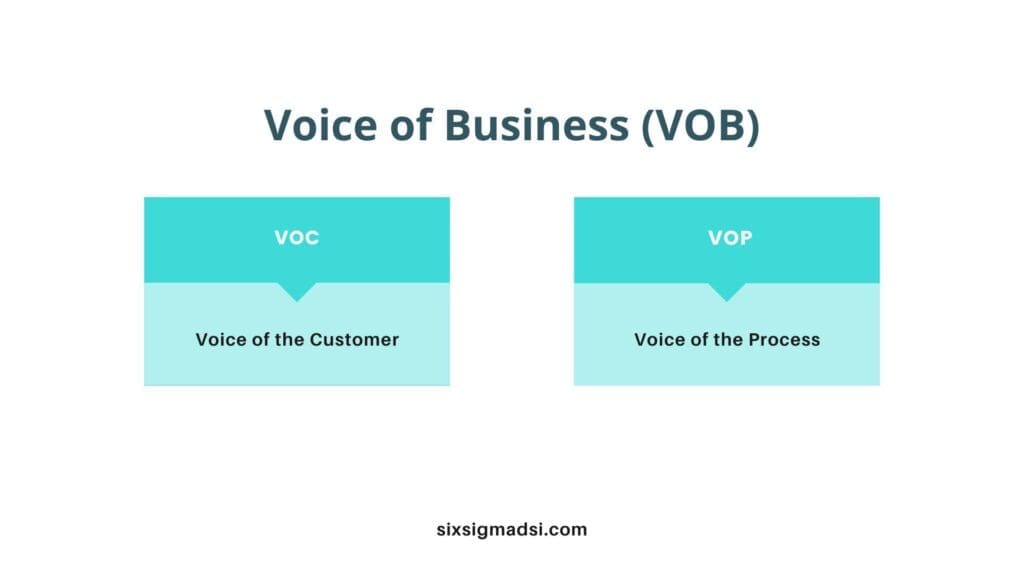Estimated reading time: 4 minutes
What Does VOB Stand For?
In the context of Six Sigma, VOB typically stands for “Voice of the Business.” The term refers to the aspects of business strategy, goals, and objectives that influence the direction and priorities of a Six Sigma project. Understanding the Voice of the Business is crucial for aligning improvement efforts with the overall objectives of the organization.
In the Six Sigma methodology, practitioners often use various tools and techniques to capture and analyze different “voices,” including the Voice of the Customer (VOC) and the Voice of the Process (VOP). These voices help organizations make data-driven decisions and improvements that are in line with customer requirements and strategic business goals.

Understanding the Importance of VOB
- Strategic Alignment:
- VOB serves as the bridge between the organization’s leadership and Six Sigma practitioners. Understanding the strategic goals of the business is essential for aligning improvement projects with overarching objectives.
- By incorporating VOB into Six Sigma initiatives, organizations can ensure that process improvements directly contribute to the achievement of business goals, thereby enhancing the overall competitiveness and market position.
- Resource Allocation:
- VOB provides insight into resource allocation priorities. Six Sigma practitioners need to understand the business’s strategic focus to allocate resources effectively and address critical areas that align with organizational priorities.
- By identifying and addressing the most critical business needs, organizations can optimize their use of resources, leading to more significant improvements in key performance indicators.
- Risk Mitigation:
- Understanding the Voice of the Business allows Six Sigma teams to assess risks and potential challenges in the context of broader business objectives.
- By considering VOB, organizations can implement risk mitigation strategies that not only address immediate concerns but also contribute to the long-term sustainability and success of the business.
- Enhanced Decision-Making:
- VOB provides a foundation for data-driven decision-making. Six Sigma projects guided by a clear understanding of the business’s voice are more likely to result in solutions that have a meaningful impact on the organization.
- Informed decision-making based on VOB ensures that improvements are aligned with the organization’s long-term vision, fostering a culture of continuous improvement.
- Leadership Support:
- By incorporating VOB into Six Sigma initiatives, practitioners can gain the support and commitment of organizational leaders.
- Demonstrating an awareness of and responsiveness to the Voice of the Business enhances the credibility of Six Sigma initiatives, fostering a collaborative relationship between process improvement teams and leadership.
Benefits of the Voice of the Business
Here are some general benefits of considering the Voice of the Business in organizational decision-making and improvement efforts:
- Strategic Alignment:
- Understanding the Voice of the Business helps align operational activities, projects, and improvement initiatives with the overarching strategic goals and vision of the organization.
- Resource Optimization:
- By incorporating the Voice of the Business, organizations can optimize resource allocation to focus on areas that are most critical to achieving long-term success and competitiveness.
- Risk Management:
- Awareness of the Voice of the Business allows for a more comprehensive assessment of risks and challenges, enabling organizations to implement strategies that mitigate potential threats to the business.
- Leadership Support:
- Considering the Voice of the Business in decision-making can enhance support from organizational leaders. When improvement initiatives are aligned with business priorities, they are more likely to gain leadership commitment and resources.
- Long-Term Sustainability:
- Decision-making based on the Voice of the Business promotes the development of solutions and improvements that contribute to the long-term sustainability and growth of the organization.
- Improved Decision-Making:
- Organizations that take the Voice of the Business into account make more informed and strategic decisions, ensuring that actions and initiatives align with the broader business context.
- Enhanced Communication:
- Considering the Voice of the Business promotes better communication between different levels of the organization. Teams can understand how their work contributes to the overall success of the business.
- Cultural Alignment:
- Incorporating the Voice of the Business into the organizational culture helps create a shared understanding of the company’s mission and values, fostering a sense of purpose among employees.
- Customer Impact:
- When improvements are made with the Voice of the Business in mind, there is a higher likelihood that these changes will positively impact customers, as they are aligned with the organization’s strategic direction.
- Adaptability to Change:
- Organizations that understand the Voice of the Business are better positioned to adapt to changes in the business environment, evolving market conditions, and emerging opportunities.
It’s important to note that the specific benefits of considering the Voice of the Business may vary depending on the industry, organizational context, and the unique goals and challenges of a particular business. If “Voice of the Business” refers to a specific concept or methodology in your organization, it would be valuable to refer to the organization’s guidelines for a more precise understanding of the associated benefits.











